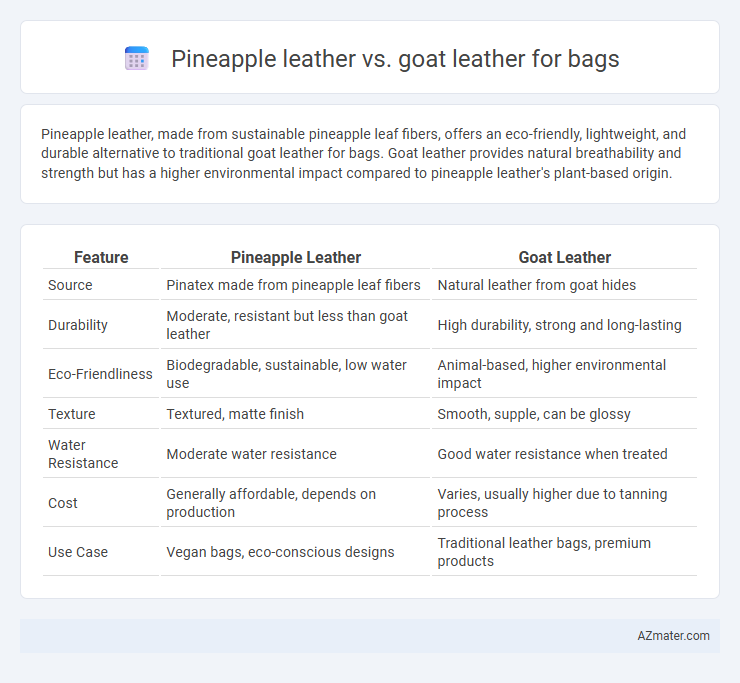Pineapple leather, made from sustainable pineapple leaf fibers, offers an eco-friendly, lightweight, and durable alternative to traditional goat leather for bags. Goat leather provides natural breathability and strength but has a higher environmental impact compared to pineapple leather's plant-based origin.
Table of Comparison
| Feature | Pineapple Leather | Goat Leather |
|---|---|---|
| Source | Pinatex made from pineapple leaf fibers | Natural leather from goat hides |
| Durability | Moderate, resistant but less than goat leather | High durability, strong and long-lasting |
| Eco-Friendliness | Biodegradable, sustainable, low water use | Animal-based, higher environmental impact |
| Texture | Textured, matte finish | Smooth, supple, can be glossy |
| Water Resistance | Moderate water resistance | Good water resistance when treated |
| Cost | Generally affordable, depends on production | Varies, usually higher due to tanning process |
| Use Case | Vegan bags, eco-conscious designs | Traditional leather bags, premium products |
Introduction to Pineapple Leather and Goat Leather
Pineapple leather, also known as Pinatex, is an innovative, sustainable material made from pineapple leaf fibers, offering eco-friendly alternatives to traditional animal-based products. Goat leather is a durable, supple, and lightweight natural leather sourced from goat hides, widely used in high-quality bags for its softness and longevity. Both materials present distinct benefits, with pineapple leather emphasizing environmental sustainability and goat leather highlighting traditional craftsmanship and durability.
Material Sourcing and Sustainability
Pineapple leather, derived from pineapple leaf fibers, offers a sustainable alternative by utilizing agricultural waste that would otherwise be discarded, significantly reducing environmental impact compared to traditional leather. Goat leather, sourced from goat hides typically raised for meat or milk, relies on animal farming practices that contribute to greenhouse gas emissions and land degradation. The production of pineapple leather requires less water and energy, making it a more eco-friendly choice for bags focused on reducing carbon footprint and promoting circular economy principles.
Durability and Longevity Comparison
Pineapple leather, made from natural pineapple leaf fibers, offers moderate durability but tends to show wear faster than traditional goat leather. Goat leather, known for its strength and flexibility, provides superior longevity with better resistance to scratches, tearing, and environmental factors. For bags intended to withstand heavy use and maintain structural integrity over time, goat leather remains the more durable and long-lasting option compared to pineapple leather.
Environmental Impact Assessment
Pineapple leather, made from agricultural waste such as pineapple leaves, offers a significantly lower environmental impact compared to goat leather, reducing deforestation and greenhouse gas emissions associated with livestock farming. The production of pineapple leather consumes less water and avoids toxic chemicals commonly used in conventional leather tanning, leading to lower soil and water pollution. Goat leather, while durable and biodegradable, involves higher resource use and methane emissions, making pineapple leather a more sustainable and eco-friendly alternative for bag manufacturing.
Visual Appeal and Texture Differences
Pineapple leather showcases a unique, natural grain pattern with a slightly fibrous texture that offers a distinctive, eco-friendly appeal contrasted with the smooth, refined finish of goat leather. Goat leather features a supple, consistent surface with a soft sheen, known for its durability and classic luxury look, while pineapple leather's irregular texture highlights its plant-based origin and artisanal craftsmanship. Visually, pineapple leather stands out with its matte, organic aesthetic, whereas goat leather provides a polished, elegant appearance ideal for traditional and premium bags.
Weight and Flexibility for Bags
Pineapple leather is notably lighter than goat leather, making it an excellent choice for lightweight bags that prioritize ease of carry. Its flexibility allows for a softer, more pliable texture, which enhances comfort without sacrificing durability. Goat leather, although heavier, offers superior strength and maintains its shape well, making it ideal for structured bags requiring long-term resilience.
Maintenance and Cleaning Requirements
Pineapple leather requires gentle cleaning with a damp cloth and mild soap, avoiding excessive water to prevent damage to its natural fibers, making it relatively low-maintenance compared to traditional materials. Goat leather, known for its durability and water resistance, can be cleaned with specialized leather cleaners and conditioned regularly to maintain suppleness and prevent cracking. Both materials benefit from avoiding prolonged exposure to direct sunlight and storing in a cool, dry place to extend the lifespan of bags.
Price Point and Market Availability
Pineapple leather typically costs more than goat leather due to its sustainable production process and limited supply, making it a premium option in the bag market. Goat leather is widely available and more affordable, favored for its durability and softness, which supports a broad range of prices across various brands. Market availability of pineapple leather remains niche, primarily in eco-conscious and luxury segments, whereas goat leather dominates mainstream bag production globally.
Ethical Considerations in Leather Choices
Pineapple leather offers a sustainable alternative to traditional animal leather by utilizing agricultural waste from pineapple leaves, significantly reducing environmental impact and avoiding animal cruelty. Goat leather, while durable and biodegradable, involves ethical concerns related to animal welfare and the environmental footprint of animal farming, including land use and greenhouse gas emissions. Choosing pineapple leather supports cruelty-free fashion and eco-friendly practices, appealing to consumers prioritizing ethics and sustainability in their leather goods.
Consumer Preferences and Future Trends
Pineapple leather appeals to eco-conscious consumers seeking sustainable and cruelty-free alternatives to traditional goat leather, often preferred for its unique texture and environmental benefits. Goat leather remains favored for its durability, natural breathability, and classic aesthetic, attracting buyers valuing longevity and premium quality. Future trends indicate a rising demand for pineapple leather in fashion accessories, driven by increasing awareness of animal welfare and innovation in plant-based materials.

Infographic: Pineapple leather vs Goat leather for Bag
 azmater.com
azmater.com